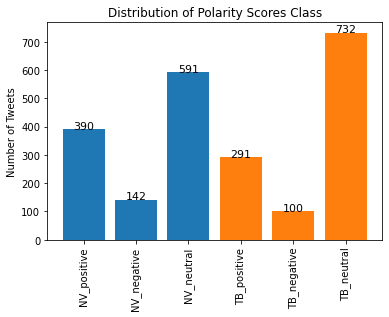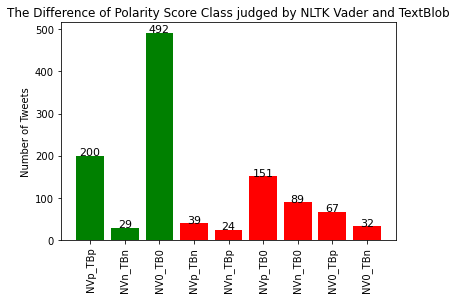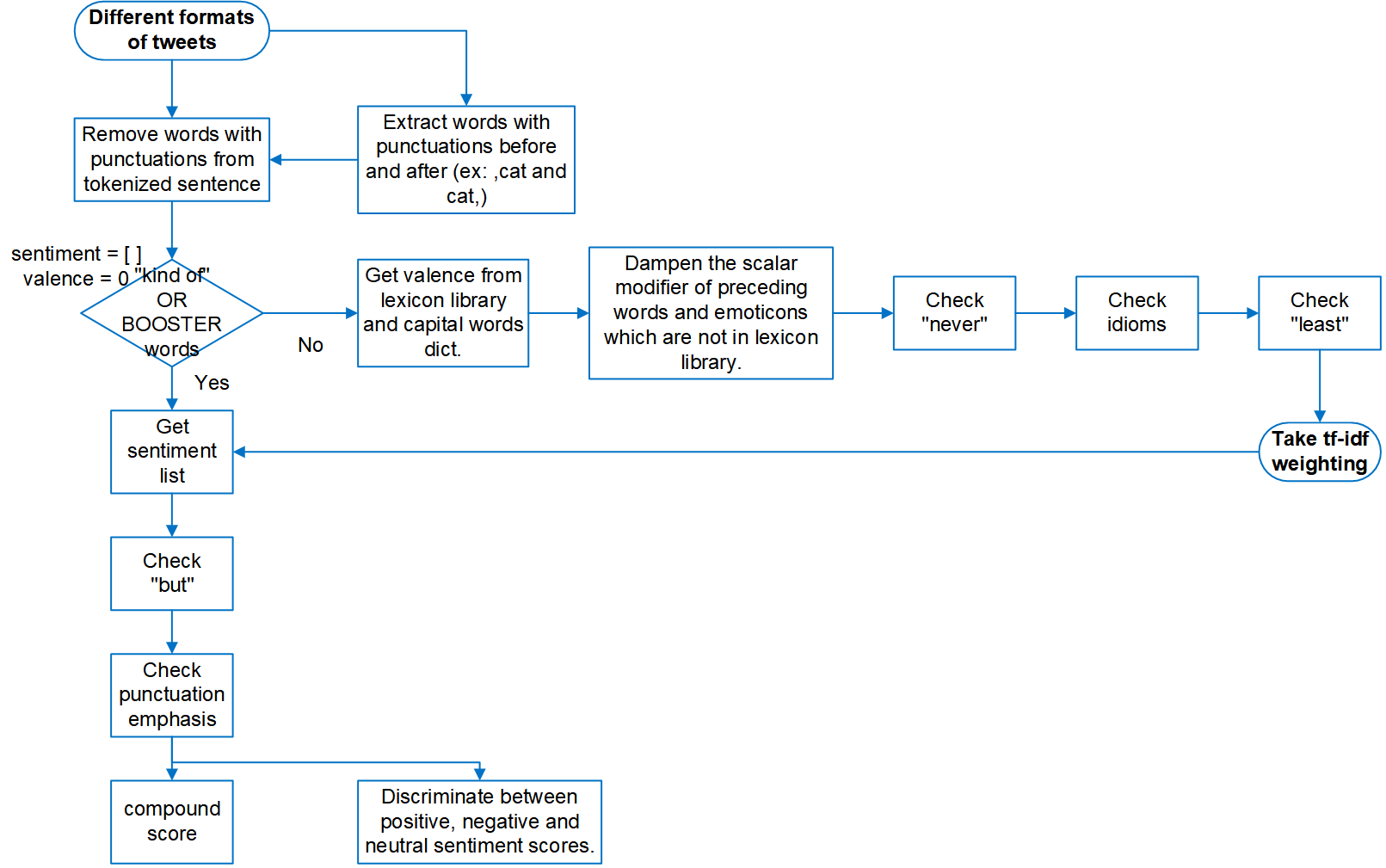Lexicon-based approaches: NLTK Vader or TextBlob?
From previous sentiment analysis on tweets of Fosun Pharma in 2020, the sentiment polarity of the same tweet judged by NLTK Vader and TextBlob is different. Besides, NLTK Vader cannot recognize the sentiment of tokenized words. This blog discusses the main differences between these two sentiment analysis approaches and shows the accuracy of them based on the tweets of Fosun Pharma in 2020.
1 Main Features
1.1 NLTK Vader
-
NLTK Vader is based on lexicon of sentiment-related words. Each words in the lexicon is rated whether it is positive or negative. There are 7052 words in its lexicon library
vader_lexicon.txtwith predetermined measures. -
When it comes to analysing comments or text from social media, the sentiment of the sentence changes when considered in context. Vader takes this into account along with emoticons(e.g. smileys is included in its lexicon), punctuation emphasis(e.g. ??? and !!!), degree modifiers, capitalization, idoms, negation words, polarity shift due to conjunctions(e.g. but) etc and hence it is a better option when it comes to tweet analysis.
Relevant codes are shown as follows:
def _least_check(self, valence, words_and_emoticons, i):
# check for negation case using "least"
if (
i > 1
and words_and_emoticons[i - 1].lower() not in self.lexicon
and words_and_emoticons[i - 1].lower() == "least"
):
if (
words_and_emoticons[i - 2].lower() != "at"
and words_and_emoticons[i - 2].lower() != "very"
):
valence = valence * self.constants.N_SCALAR
elif (
i > 0
and words_and_emoticons[i - 1].lower() not in self.lexicon
and words_and_emoticons[i - 1].lower() == "least"
):
valence = valence * self.constants.N_SCALAR
return valence
def _but_check(self, words_and_emoticons, sentiments):
# {"but", "BUT"} & set(['you','but','me','BUT','me']) ==> {'BUT', 'but'}
but = {"but", "BUT"} & set(words_and_emoticons)
if but:
# next(iter({'BUT', 'but'})) ==> 'BUT'
bi = words_and_emoticons.index(next(iter(but)))
for sidx, sentiment in enumerate(sentiments):
if sidx < bi:
sentiments[sidx] = sentiment * 0.5
elif sidx > bi:
sentiments[sidx] = sentiment * 1.5
return sentiments
def _idioms_check(self, valence, words_and_emoticons, i):
# check word terms
onezero = "{0} {1}".format(words_and_emoticons[i - 1], words_and_emoticons[i])
twoonezero = "{0} {1} {2}".format(
words_and_emoticons[i - 2],
words_and_emoticons[i - 1],
words_and_emoticons[i],
)
twoone = "{0} {1}".format(
words_and_emoticons[i - 2], words_and_emoticons[i - 1]
)
threetwoone = "{0} {1} {2}".format(
words_and_emoticons[i - 3],
words_and_emoticons[i - 2],
words_and_emoticons[i - 1],
)
threetwo = "{0} {1}".format(
words_and_emoticons[i - 3], words_and_emoticons[i - 2]
)
sequences = [onezero, twoonezero, twoone, threetwoone, threetwo]
for seq in sequences:
if seq in self.constants.SPECIAL_CASE_IDIOMS:
valence = self.constants.SPECIAL_CASE_IDIOMS[seq]
break
if len(words_and_emoticons) - 1 > i:
zeroone = "{0} {1}".format(
words_and_emoticons[i], words_and_emoticons[i + 1]
)
if zeroone in self.constants.SPECIAL_CASE_IDIOMS:
valence = self.constants.SPECIAL_CASE_IDIOMS[zeroone]
if len(words_and_emoticons) - 1 > i + 1:
zeroonetwo = "{0} {1} {2}".format(
words_and_emoticons[i],
words_and_emoticons[i + 1],
words_and_emoticons[i + 2],
)
if zeroonetwo in self.constants.SPECIAL_CASE_IDIOMS:
valence = self.constants.SPECIAL_CASE_IDIOMS[zeroonetwo]
# check for booster/dampener bi-grams such as 'sort of' or 'kind of'
if threetwo in self.constants.BOOSTER_DICT or twoone in self.constants.BOOSTER_DICT:
valence = valence + self.constants.B_DECR
return valence
def _never_check(self, valence, words_and_emoticons, start_i, i):
# 'never' is a type of emphasize word
if start_i == 0:
if self.constants.negated([words_and_emoticons[i - 1]]):
valence = valence * self.constants.N_SCALAR
if start_i == 1:
if words_and_emoticons[i - 2] == "never" and (
words_and_emoticons[i - 1] == "so"
or words_and_emoticons[i - 1] == "this"
):
valence = valence * 1.5
elif self.constants.negated([words_and_emoticons[i - (start_i + 1)]]):
valence = valence * self.constants.N_SCALAR
if start_i == 2:
if (
words_and_emoticons[i - 3] == "never"
and (
words_and_emoticons[i - 2] == "so"
or words_and_emoticons[i - 2] == "this"
)
or (
words_and_emoticons[i - 1] == "so"
or words_and_emoticons[i - 1] == "this"
)
):
valence = valence * 1.25
elif self.constants.negated([words_and_emoticons[i - (start_i + 1)]]):
valence = valence * self.constants.N_SCALAR
return valence
def _punctuation_emphasis(self, sum_s, text):
# add emphasis from exclamation points and question marks
ep_amplifier = self._amplify_ep(text)
qm_amplifier = self._amplify_qm(text)
punct_emph_amplifier = ep_amplifier + qm_amplifier
return punct_emph_amplifier
def _amplify_ep(self, text):
# check for added emphasis resulting from exclamation points (up to 4 of them)
ep_count = text.count("!")
if ep_count > 4:
ep_count = 4
# (empirically derived mean sentiment intensity rating increase for
# exclamation points)
ep_amplifier = ep_count * 0.292
return ep_amplifier
def _amplify_qm(self, text):
# check for added emphasis resulting from question marks (2 or 3+)
qm_count = text.count("?")
qm_amplifier = 0
if qm_count > 1:
if qm_count <= 3:
# (empirically derived mean sentiment intensity rating increase for
# question marks)
qm_amplifier = qm_count * 0.18
else:
qm_amplifier = 0.96
return qm_amplifier
- The compound score is computed by summing the valence scores of each word in the lexicon, adjusted according to the rules, and then normalized to be between -1 (most extreme negative) and +1 (most extreme positive).

where x is sum of valence scores of words in the sentences, and α is normalization constant (default value is 15).
1.2 TextBlob
- TextBlob also has a lexicon library,
en-sentiment.xml, an XML document that includes the different senses for the same word and identified by different ids. There are 2919 records collected by this lexicon library. TextBlob also handles negation (e.g. not) and modifier words (e.g very).
An example of the word entries in lexicon library:
-
TextBlob can identify different entities based on its entities library,
en-entities.txtand tag phrases by Parts of Speech (POS). -
When calculating sentiment for a single word, TextBlob simply takes average of different entries for the same word. TextBlob goes along finding words and phrases it can assign polarity and subjectivity to, and it averages them all together for longer text. (e.g. multiply polarity by negation’s measure , the inverse intensity of the modifier enters for both polarity and subjectivity.)
1.3 Comparison and Conclusion
NLTK Vader should be more suitable for our data.
Both of the two approaches analyze the text according to thier lexicon library. NLTK Vader focus on analyzing in context by considering the word terms and conjunctions, whereas TextBlob takes entities into consideration by POS. The tweets we collected are mainly about stocks, so POS may not be suitable for our data (e.g. AAPL is more likely to appear than Apple Inc., and the analysis on tags LOCATION and PERSON are not very meaningful).
Besides, NLTK Vader also considers emoticons so it works better for texts from social media.
2 Sentiment Polarity Scores and Accuracy

Among 1123 tweets of Fosun Pharma in 2020, the result given by NLTK Vader is that 390(34.73%), 142(12.64%) and 591(52.63%) are positive, negative and neutral respectively, while TextBlob says that 291(25.91%), 100(8.90%) and 732(65.18%) are positive, negative and neutral respectively.
Both of these two approaches conclude that positive sentiment in tweets is greater than negative sentiment. However, the numbers in each polarity score class are not the same. More neutral results are produced by TextBlob.

200 of the 1123 tweets are judged to be positive by both of these two approaches, and 29 and 492 are judged to be negative and neutral. They have different results on the polarity of the remaining 402 tweets. NLTK Vader gives positive and negative sentiment score for the 151 and 89 tweets, but TextBlob says they are neutral. So, NLTK Vader seems to be more sensitive to our sample tweets than TextBlob.
After scoring these 402 tweets manually and comparing the results given by these two approaches, NLTK Vader gives accurate sentiment polarity to 181 of the tweets whereas TextBlob gives accurate sentiment polarity to 139 of the tweets.
In overall, the accuracy of NLTK Vader in judging the sentiment polarity of the 1123 tweets is 80.14% and that of TextBlob is 76.58%.
3 Modifications on NLTK Vader’s code

Furthermore, we add a revising step based on tf-idf weighting to weaken the polarity score of the most frequent words in all the tweets for NLTK Vader. The accuracy in judging the sentiment polarity of the 1123 tweets is now 79.88%, which is less than before. This adjustment cannot improve NLTK Vader’s correct rate on sentiment analysis of Fosun Pharma’s tweets.